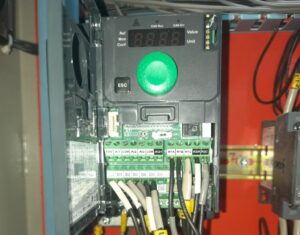
Chokes, or line reactors, are commonly used both in the incoming (input) and outgoing (output) areas of Variable Frequency Drive (VFD) installations. The purpose of using chokes in both areas is to provide various benefits and ensure the reliable and efficient operation of the VFD system. Here’s an explanation of why chokes are used in both the incoming and outgoing areas:
Incoming Choke (Input Choke)
Harmonic Mitigation
VFDs generate harmonic currents due to the nonlinear nature of their power conversion process. These harmonics can cause voltage distortion, leading to reduced power quality and potential issues for the connected equipment. An incoming choke is used to limit the flow of harmonic currents, reducing the impact on the power supply and improving overall system performance.
Voltage Spike Protection
Incoming chokes protect the VFD from voltage spikes or transients that can occur in the power supply. These voltage disturbances can damage the VFD or affect its operation. The choke acts as a filter, attenuating high-frequency voltage spikes and providing protection against transient events.
Inrush Current Limitation
Incoming chokes help limit the inrush current during VFD startup by slowing down the rate of current rise. Inrush current can be several times higher than the motor’s rated current, and the choke helps reduce this current, preventing stress on the VFD and other components in the system.
Outgoing Choke (Output Choke)
Motor Protection
An outgoing choke is primarily used to protect the motor connected to the VFD. It helps mitigate voltage stress on the motor winding by reducing the rate of voltage rise, smoothing out voltage transitions, and providing impedance to high-frequency components. This protection helps enhance motor performance, reduce insulation stress, and increase motor lifespan.
Motor Cable Length Compensation
The impedance introduced by an outgoing choke compensates for the capacitance and inductance effects of long motor cables. Long cables can create voltage reflections and reduce system efficiency. The outgoing choke helps to mitigate these effects and improve the voltage waveform quality at the motor terminals.
Reduced Motor Bearing Currents
Chokes in the output area help minimize the occurrence of bearing currents, which can cause premature bearing failure. The choke acts as a buffer, limiting the flow of high-frequency currents that can circulate through the motor bearings, reducing the risk of damage and extending bearing life.
Using chokes in both the incoming and outgoing areas of VFD installations helps address various issues such as harmonic distortion, voltage spikes, inrush current, motor protection, cable compensation, and bearing current reduction. The specific selection and sizing of chokes should be based on the VFD and motor specifications, harmonic distortion limits, and other system requirements. Consulting with manufacturers, following industry guidelines, and considering the specific application needs are essential for the proper implementation of chokes in VFD installations.
